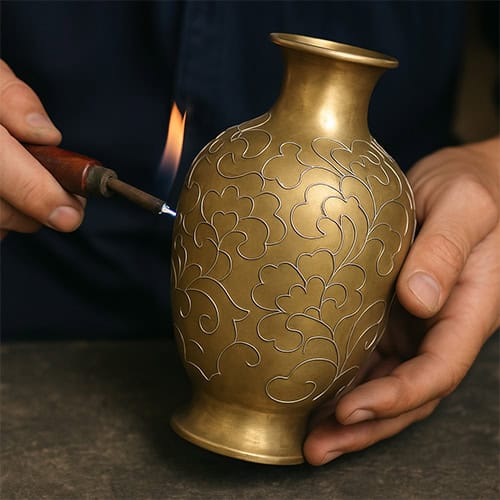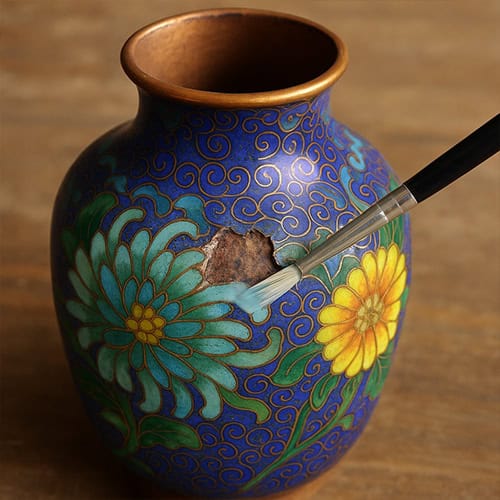
Cloisonné is a centuries-old enameling technique used to create intricate, colorful designs on metal objects by fusing enamel (a type of powdered glass) into compartments formed by delicate metal wires. These metal wires, usually made of copper, brass, or silver, are affixed to the surface of a metal object to form decorative outlines or patterns. The compartments, called cloisons (from the French word for “partitions”), are then filled with colored enamel pastes, fired in a kiln, and polished to create a smooth, glassy surface.
This technique has been used across various cultures and historical periods, often to decorate vases, bowls, boxes, jewelry, and religious items. Cloisonné is admired for its vivid color, precision, and the fine metal outlines that lend a sense of detail and refinement to each piece.
Today, cloisonné is most commonly associated with Chinese and Japanese decorative arts, although its origins trace back to the ancient Near East, and it has been practiced and adapted by many different cultures over the centuries.
Cloisonné Through the Ages: A Quick Timeline
- c. 1500 BCE – Early cloisonné-style inlays found in Egypt and Cyprus, using gold and gemstones
- 6th–12th centuries CE – Cloisonné flourishes in the Byzantine Empire with religious icons and jewelry
- 13th–14th centuries – Technique travels via Islamic and Silk Road routes to China
- 15th century – Chinese Ming Dynasty refines cloisonné; Xuande period (1426–1435) marks earliest surviving examples
- 17th–19th centuries – Cloisonné reaches artistic heights in China under the Qing Dynasty; also adopted in Europe and Russia
- Mid-1800s – Japan revives and innovates cloisonné during the Meiji era (1868–1912), producing highly refined works
- Today – Cloisonné remains an admired art form, collected and recreated by artisans worldwide
The Process of Making Cloisonné
- Base Creation: A metal object (commonly copper or brass) is shaped into the desired form.
- Wire Application: Thin metal wires are bent and glued or soldered onto the surface to form enclosed patterns.
- Enamel Filling: Each compartment is carefully filled with enamel paste, often in multiple stages for different colors.
- Firing: The piece is fired at high temperatures in a kiln, which melts and fuses the enamel into a glassy surface.
- Polishing and Finishing: After firing, the surface is polished smooth, and the metal wires are often gilded for a brilliant finish.
The result is a dazzling and intricate design with jewel-like colors separated by fine metal outlines.
The Hidden Skill: Predicting Color Through Fire
One of the most remarkable aspects of cloisonné craftsmanship lies in a challenge invisible to the casual observer: the enamel powder applied during production looks completely different before it is fired.
The enamel is made from finely ground glass mixed with various metal oxides, and these powders appear chalky, dull, or pastel when applied. For example, what looks like pale gray powder may fire into a deep cobalt blue, while a murky beige might transform into a brilliant emerald green. The exact color transformation depends on the composition of the enamel and the temperature and atmosphere inside the kiln.
This means that cloisonné artists must have an expert understanding of how each enamel color reacts during firing. They work almost blind, applying muted, powdery colors with the knowledge that the real hues will only emerge after firing — often after multiple rounds.
On top of that, many cloisonné pieces require multiple firings, especially when layering different colors. Each firing increases the risk of defects: cracking, color bleeding, warping of the metal base, or even bubbling. Lighter or more delicate colors are usually added last, as they are more susceptible to damage from repeated heating.
This expertise makes cloisonné an art of anticipation and chemistry. Artists must plan the color palette, firing order, and wire design in advance, trusting their skill and experience to yield the desired results.
So while the final piece may appear effortlessly beautiful, its creation was likely the result of dozens of precise decisions and high-stakes firings that tested both the artist’s aesthetic eye and technical knowledge.
Why Cloisonné Matters
Cloisonné is more than just a decorative art; it is a blend of metallurgy, chemistry, and aesthetic philosophy. From sacred relics to imperial treasures, cloisonné has been used to convey status, spirituality, and artistry throughout history. For collectors and art historians, understanding cloisonné offers a window into cultural exchange, technological development, and artistic trends across time and geography.
Whether you’re an avid collector, a casual admirer, or a student of decorative arts, exploring cloisonné can be a rewarding journey into the world of craftsmanship and creativity.
Market Trends and Value: Chinese vs. Japanese Cloisonné
In today’s market, cloisonné is highly collectible, and values can vary widely based on factors like age, condition, provenance, and especially country of origin.
Chinese cloisonné, especially from the Ming (1368–1644) and Qing (1644–1912) dynasties, is often more valuable in the eyes of collectors due to its historical depth and association with the imperial court. Some pieces were commissioned directly by the emperor and are considered imperial cloisonné, comparable to imperial porcelain. These works typically feature elaborate motifs (like five-clawed dragons, phoenixes, or lotus scrolls), are of larger scale, and may include gilt bronze mounts or reign marks. They are prized not just for beauty but for their cultural and political significance. Authentic imperial cloisonné can reach six- or seven-figure sums at auction.
By contrast, export cloisonné — mass-produced for Western markets in the 19th and 20th centuries — tends to be more decorative than refined. These pieces are often lighter, more standardized, and carry lower market values, though some still have strong collector appeal.
Japanese cloisonné, particularly from the Meiji era (1868–1912), is considered the technical pinnacle of the art. Makers like Namikawa Yasuyuki, Namikawa Sōsuke, and Ando Jubei pushed the medium to unprecedented levels of detail and artistry, sometimes surpassing Chinese work in refinement. High-end Meiji-era Japanese cloisonné is incredibly sought after, especially pieces signed by known masters.
In terms of value, Japanese Meiji cloisonné can command extremely high prices — especially museum-quality pieces or those made using advanced techniques like musen (wireless) or plique-à-jour (transparent) cloisonné. However, in the broader market, imperial Chinese cloisonné generally commands the highest premiums, especially with confirmed provenance.
Key market trends:
- Condition is critical: chips, cracks, or missing enamel greatly reduce value.
- Provenance and marks (e.g., imperial reign marks or artist signatures) can dramatically influence price.
- Demand is strong for both Chinese and Japanese high-end pieces, especially at international auctions.
- Early or imperial Chinese cloisonné remains a trophy category for collectors of Asian art.
If you’re collecting or investing, it’s crucial to distinguish between imperial, workshop, and export cloisonné — much like the categories used in porcelain collecting.
💰 Cloisonné Price Guide: From Museum Masterpieces to Affordable Finds
Cloisonné spans a wide price range depending on origin, age, technique, condition, and provenance. Whether you’re browsing auctions or flea markets, here’s what you can expect:
🏛️ Record-Breaking Cloisonné Prices
- The highest recorded price for a cloisonné item was achieved at Christie’s Hong Kong in 2010, when a massive 15th-century Ming dynasty cloisonné enamel double-gourd vase sold for HK$90,260,000 (approx. £9 million).
- Other exceptional imperial Qing pieces with dragon motifs and reign marks have sold for £1–2 million+ at top auction houses like Sotheby’s and Bonhams.
- These top-tier examples are typically from the Xuande (1426–1435), Jingtai (1450–1457), or Qianlong (1736–1795) periods.
🎨 High-End Collectible Cloisonné (Chinese & Japanese)
- Imperial-style Chinese cloisonné from the 18th–19th century:
£3,000–£50,000+, depending on size, decoration, and provenance. - Japanese Meiji-era cloisonné by master artists (e.g. Namikawa Yasuyuki or Ando Jubei):
£1,500–£30,000 for signed, high-quality works. - Musen or plique-à-jour techniques can fetch £5,000+ due to complexity and rarity.
🧭 Mid-Range Antique Cloisonné
- Late Qing Chinese vases (late 19th–early 20th century) in good condition:
Typically £300–£1,500. - Unsigned Meiji or Taishō-era Japanese cloisonné (small vases, plates):
Range from £200–£800, depending on design quality and condition. - Decorative European or Russian cloisonné items (e.g. boxes, cups):
Often £150–£600, though Fabergé pieces can go much higher.
🏷️ Entry-Level & Modern Cloisonné
- 20th-century Chinese export cloisonné (1930s–1970s):
Often £30–£150 for vases, bowls, or ashtrays. Mass-produced but still hand-crafted. - Late 20th-century tourist cloisonné (1980s–2000s):
Can be found for £20–£50, especially at antique fairs, car boot sales, or online. - These are perfect for beginners or decorative use, but hold limited resale value.
Caring for and Displaying Cloisonné
Cloisonné may look like solid metal and glass, but it is surprisingly delicate. Preserving its beauty requires some care and attention:
- Avoid Impact: The enamel is glass-based and can crack or chip if dropped or knocked. Handle pieces with care, especially around edges and rims.
- Temperature Caution: Sudden changes in temperature can cause the enamel to expand or contract, potentially leading to cracks.
- Cleaning Tips: Use a dry or slightly damp soft cloth (like microfiber) to wipe off dust. Avoid abrasive cloths, cleaning sprays, or chemical polishes.
- Display Safely: Display in a stable, upright position. Avoid placing on hard surfaces without soft padding underneath.
- Light Exposure: While cloisonné isn’t especially sensitive to light, extended exposure to intense sunlight may cause colors to fade slightly over time.
By following these tips, you can enjoy and preserve your cloisonné for generations.
🛠️ Cloisonné Restoration: Can It Be Done, and Is It Worth It?
Cloisonné can be restored — but it’s a highly specialized and expensive process. Because cloisonné involves metal, glass, and heat, repairing it isn’t like touching up paint or patching ceramics. Restoring even a small area requires a deep understanding of chemistry, firing conditions, and enamel behavior.
🔄 Can Cloisonné Be Restored?
Yes, but with limits. Small chips, cracks, or missing enamel areas can often be repaired by:
- Reapplying matching enamel powder to the damaged cloisons
- Carefully re-firing the piece in a kiln to fuse the enamel
- Grinding and polishing to match the original finish
However, larger damage (e.g., dents, warping, structural cracks) is more difficult — sometimes impossible — to fix without leaving visible differences. Broken wires may also need to be reshaped or replaced, which requires microscopic precision.
🔥 Why Is It So Expensive?
Cloisonné restoration is costly for several reasons:
- Re-firing must match original temperature and timing — too hot or too long, and the surrounding enamel may melt, change color, or crack.
- Matching antique enamel colors is difficult — because older enamel colors were made with now-restricted metal oxides (like lead, arsenic, or mercury compounds).
- The entire section of the piece may need re-polishing, or the new enamel may sit slightly higher or lower than the original, requiring delicate leveling.
- Restoration artists must blend new work invisibly — a skill that only a handful of professionals worldwide can do with cloisonné.
💷 How Much Does Restoration Cost?
Prices vary greatly depending on the extent of damage and the restorer’s expertise:
- Minor chip repair: £100–£300
- Moderate enamel loss or rewiring: £400–£1,000+
- Extensive damage (e.g. large cracks, structural issues): Often not recommended unless the piece has major historic or monetary value
Antique restorers may charge even more due to risk, insurance, and research involved in matching techniques and materials.
⚠️ Will It Affect Value?
Yes — and often negatively.
Even a well-restored piece is usually worth less than a comparable unrestored example. That said, for rare or sentimental pieces, expert restoration can:
- Stabilize the item for display
- Prevent further damage
- Retain some collectible value (if fully disclosed)
Restoration should always be disclosed if selling — and ideally documented with before/after images and the restorer’s credentials.
Common Myths and Misconceptions About Cloisonné
Even seasoned collectors sometimes misunderstand cloisonné. Here are some of the most common myths:
- “If it’s old, it must be Chinese.” → Not necessarily. Japanese cloisonné from the Meiji era is just as old and often more technically advanced.
- “Painted metal is cloisonné.” → No. Cloisonné specifically involves enamel fused into wire-formed cells. Painted imitations exist and can be mistaken at first glance.
- “Heavy means better quality.” → Not always. Japanese cloisonné often uses a thinner copper base for delicate work, while French champlevé can be heavier due to solid cast metal.
- “All cloisonné has turquoise interiors.” → Common in Chinese examples, but Japanese cloisonné often has green or clear enamel interiors, and some modern or export pieces have bare metal inside.
- “Cloisonné is all about decoration.” → While decorative, cloisonné often carries deep symbolism, especially in Chinese imperial and religious pieces.
Understanding these distinctions will help you recognize authentic cloisonné, avoid misattributions, and appreciate the true craftsmanship involved.
✅ Cloisonné Identification Checklist
Use this checklist to help determine if a piece is genuine cloisonné and possibly identify its origin or quality.
This list isn’t definitive, but it will help guide your initial assessment.
- Are fine metal wires clearly forming the borders…
Are fine metal wires clearly forming the borders of each design element? This is the core feature of cloisonné. - Smooth, glassy enamel surface?
The enamel should be vitrified (glass-like), not painted or rough. - Traditional motifs?
- Chinese: dragons, phoenixes, lotus, ruyi clouds
- Japanese: birds, chrysanthemums, naturalistic flowers or landscapes
- Chinese: dragons, phoenixes, lotus, ruyi clouds
- Enamel on the interior or underside?
- Chinese: often turquoise or white enamel inside
- Japanese: often opaque green or clear enamel
- European: often bare metal or painted imitation
- Chinese: often turquoise or white enamel inside
- Wire type and fineness?
- Thick brass wires: typical of Chinese work
- Ultra-fine silver or gold wires: common in high-end Japanese pieces
- Thick brass wires: typical of Chinese work
- Maker’s marks or reign marks?
- Japanese Meiji-era works are often signed
- Chinese imperial pieces may include reign marks (rare)
- Japanese Meiji-era works are often signed
- Weight and feel?
Heavier: could be champlevé or robust Chinese cloisonné
Lighter: more likely Japanese (thin copper body) - Wireless or musen technique?
Smooth gradients with no visible wires may indicate Japanese wireless cloisonné - Condition check:
Are there chips, cracks, or missing enamel areas? Condition greatly affects value. - Export vs. domestic clue?
- Simplified patterns or Western floral motifs may suggest export ware
- Imperial or workshop pieces often show exceptional refinement and cultural symbolism
- Simplified patterns or Western floral motifs may suggest export ware
Glossary of Cloisonné Terms
- Cloison: A small compartment or cell created by bending thin metal wire, which holds the enamel powder during firing.
- Enamel: A glass-based substance made of powdered silica and metal oxides that is fused onto metal surfaces during high-temperature firing.
- Kiln: A high-temperature furnace used to fire enamel so it fuses and becomes smooth and glassy.
- Musen (Wireless Cloisonné): A Japanese technique where wires are removed before firing, resulting in smooth transitions of color without visible partitions.
- Plique-à-jour: A technique where enamel is applied within cloisons that have no metal backing, creating a stained-glass effect.
- Oxides: Metal compounds added to enamel to produce specific colors when fired (e.g., cobalt for blue, copper for green).
- Imperial Cloisonné: High-quality Chinese cloisonné made for the imperial court, often featuring specific motifs and superior craftsmanship.
- Export Cloisonné: Mass-produced cloisonné intended for foreign markets, usually made with simplified motifs and lighter construction.
- Champlevé: A different enameling technique where recesses are carved into the metal and then filled with enamel, without using wires.
- Base Metal: The core material (typically copper, brass, or bronze) to which cloisonné enamel and wire are applied.
Explore More: These Articles Will be Added Soon
To dive deeper into the history, regional styles, and differences between similar enamel techniques, explore our related articles:
- The Origins of Cloisonné: From Ancient Egypt to the Ming Dynasty
- Chinese Cloisonné: Imperial Artistry and Symbolism
- Japanese Cloisonné: The Meiji Masterpieces
- French Champlevé Enamel: How It Differs from Cloisonné
- How to Identify Cloisonné by Region and Technique
Each article will provide in-depth information, expert tips, and high-quality images to help you identify, appreciate, and possibly collect cloisonné with confidence.
Stay tuned as we continue publishing guides and insights on cloisonné and related decorative arts.
Written by Walter Edward O’Neill
Antique dealer, restoration expert, and founder of AntiquesArena.com

Table of Contents









